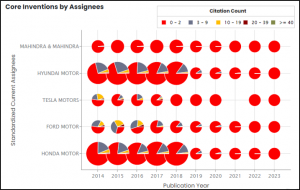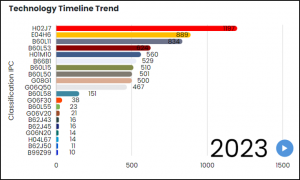
Knowledge is power when it comes to making sound business decisions. Businesses can use a variety of resources to make informed decisions about their business strategies. Patent analysis is one of these resources, and it can provide valuable insights into intellectual property and related fields.
Companies can gain a competitive advantage, reduce the risk of litigation, and maximize the value of their intellectual property investments by using patent analysis to support business decisions. We will discuss the significance of patent analysis and how it can be used to support business decisions in this blog post. We will look at the various types of patent analysis and offer advice on how to make the most of this powerful tool.
Using patent analytics, go from cost center to strategic business partner.
Patent data has evolved into a strategic business tool. Patent data analytics is the in-depth examination of such patent data in order to generate data-backed insights that aid decision-making in a variety of business situations. By leveraging these insights, the IP department is well positioned to become a partner in the formulation of the business strategy. Here are some of the business cases where patent analytics insights can have a significant impact:
- Trend prediction: What will be the next trend or disruptive technology in my industry?
- Supporting mergers and acquisitions: Can the acquisition target’s patent portfolio help bridge the gap in our current technology landscape?
- Identifying commercial potential: Who are the possible business partners or patent licensees? Are there any other ways to monetize patents?
- Risk assessment: Is the patent valid? Do I violate any existing patent rights?
- Guiding R&D: What is the best R&D strategy? What is the technological change trend?
- Evaluating the portfolio: What are my patent portfolio’s strengths, weaknesses, opportunities, and threats (SWOT)?
What can go wrong when patent data is incorrect?
It is, however, difficult to provide reliable patent insights. One of the most significant challenges is data quality. If the data used to perform the analysis is inaccurate, the results of the patent analysis will be equally so. This may result in incorrect or misleading business decisions, which can cause significant financial harm and harm your IP department’s reputation.
Incomplete ownership information is a common reason for difficulties working with patent data. Patents do not always identify the entity that will ultimately control them. They may be filed under various names, such as subsidiaries or inventors, making a comprehensive company profile nearly impossible to generate.
Another issue with the raw data is the lack of complete legal status information. Patents typically have a life span of 20 years, but they may become inactive before that time due to factors such as nonpayment of fees or invalidation.
A patent database contains a plethora of data points that are similar. Complete and accurate data is required to ensure reliable patent analytics results and make well-informed strategic decisions focused on these results.
Qualitative metrics assist you in determining true portfolio strength.
Often, just a few key patents in a portfolio are important. The majority of other patents are of little or no economic value. As a result, simply counting patents in a portfolio does not provide useful information about a company’s overall patenting or innovative strength.
Instead, creating a qualitative metric is critical for reaching the right business conclusions. Important indicators in a comprehensive patent analysis include, for example, the relative business value of each patent family, the time frame for which the patent has been in force, as well as the total number of patent citations.
Another barrier to providing reliable patent insights is the lack of current data. A regularly updated patent database provides the most recent patent documents as well as new information on the most significant technological and market developments. This will assist technology leaders in remaining at the cutting edge of technological innovation.
Providing actionable insights to business leaders through patent analysis
While we’ve already discussed some of the key benefits of patent analytics, let’s look more closely at specific use cases supported by patent analysis insights.
Competitive Benchmarking

It is critical in business to keep your competitor’s progress in mind. Benchmarking has long been a reliable method for this. A significant issue that decision makers face with organizational benchmarking is that if the proper targets are not set, the company risks achieving unsatisfactory results. This holds true for all of the benchmarked metrics, including the value of a patent portfolio. Insights gained from patent analysis, such as competitors’ overall portfolio quality, geographical spread, or type of technologies in focus, will assist businesses in ensuring they are on the right track in their business.
Technology Trend Scouting

Scouting is the systematic observation of changes, opportunities, and relevant technological developments and processes. Patent data analytics can provide invaluable insights. It can help identify disruptive innovations early on, reveal R&D trends, and investigate complementary technologies, among other things.
XLSCOUT Patent Analysis Platform – Gain Unparalleled Insights to Support Key Intellectual Property Activities
How can I ensure the accuracy of the data I need to make sound business decisions? What can assist me in identifying trends and disruptive technologies early on? How should I monetize my intellectual property? XLSCOUT is the solution to these and other critical IP issues.
Our patent analysis platform’s powerful data analysis and visualization capabilities will provide you with unparalleled insights and better-informed decision-making as an innovation-focused leader.
- Competitive intelligence & benchmarking: Monitor and analyze technological landscapes and competitors’ R&D strategies to identify emerging trends early.
- Sustainable innovation analytics: Gain actionable insights into how sustainably centered you and your competitors are, as well as conduct an objective patent analysis as per the United Nations SDGs (SDGs).
- Risk assessment: Successfully mitigate risks that could harm your business while keeping track of your competitors in recent and potential technological fields.
- R&D and innovation: Increase your innovation performance by becoming well-versed in technologies, competitors, and partners. XLSCOUT’s Techscaper provides a comprehensive overview of relevant technology areas and assists in the identification of new growth areas.
- Portfolio management and optimization: Evaluate the competitive strengths and weaknesses of your patent portfolio with powerful visualization tools. These tools help gain a better understanding of what strategies are required to stay ahead of the competition.

